Make your LinkedIn posts more professional
6 simple tips to close your LinkedIn posts like an expert
You know what I hear every day when I talk to other marketing or sales professionals?
"Content Is King."
That phrase has become what "Always Be Closing" was to the 90s – a modern mantra for the motivated marketer and a standard slogan for the successful salesperson.
Every pundit out there will tell you that it's absolutely essential to establish yourselves and your company as a leader through your posts, social media content, etc. But how do you use those posts to drive results? Do you push your CTAs at the beginning? Do you close with your sales pitch? What should be your social media strategy?
I thought it'd be interesting to see how the experts do it, so I went and took a look at the experts – key sales and marketing experts, entrepreneurs and influencers – and their LinkedIn posts. What I found about their marketing strategy was quite interesting.
Why LinkedIn?
Because it's fast becoming an excellent medium where business professionals go to read quality content published by major influencers.
Why the close specifically?
Because I think it's where the last impression is made. There're a lot of ways to improve and optimize the beginning and the headline (here's a nice little article on how to improve your LinkedIn post), but the close is something that people tend to dismiss with a "put an effective CTA there", without really going into much detail.
Anyway, back to this article.
The experts seem to close their posts in specific ways, and I've put them in six categories:
1. THE BOILERPLATE APPROACH
The preferred approach for well-established entrepreneurs and key influencers.
This is using a standard boilerplate template that is appended to the end of every post. It’s a no-nonsense, no-frills approach that tells you about the influencer, about what they offer and the various services and offerings that they provide. I think this is because they don't need to encourage new traffic – they have hit "critical mass" and established themselves as such a major brand that their following grows on its own, like an uncontrolled chain reaction.
When Jeff Bullas or Tim Hughes writes a post, their objective is mostly to re-establish themselves and remind you of their expertise. The brand they promote is themselves. They have multiple offerings and services that they are providing and they have already established an audience that will naturally return regularly to see each new post.
Here’s how Tim Hughes tends to close his posts:

There’s the standard value-proposition from his agency.

Followed by a plug for his book, re-establishing himself as an authority on social selling.
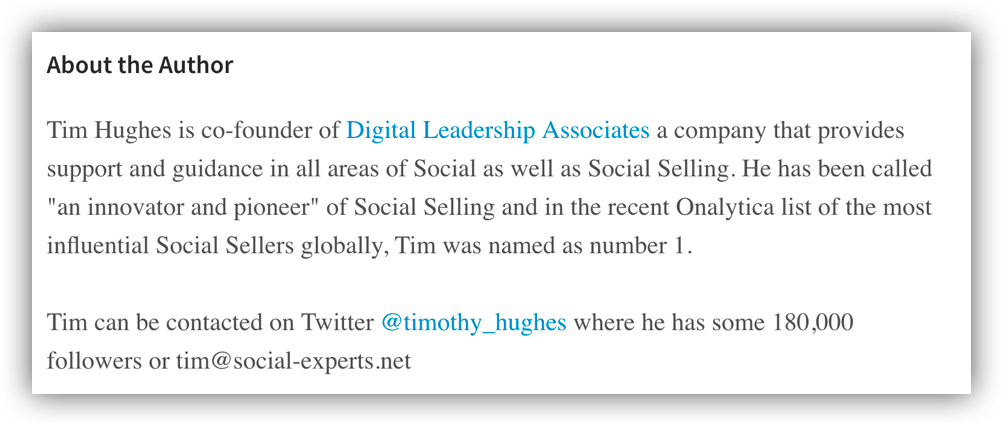
After which you have a brief "greatest hits" bio about Tim.
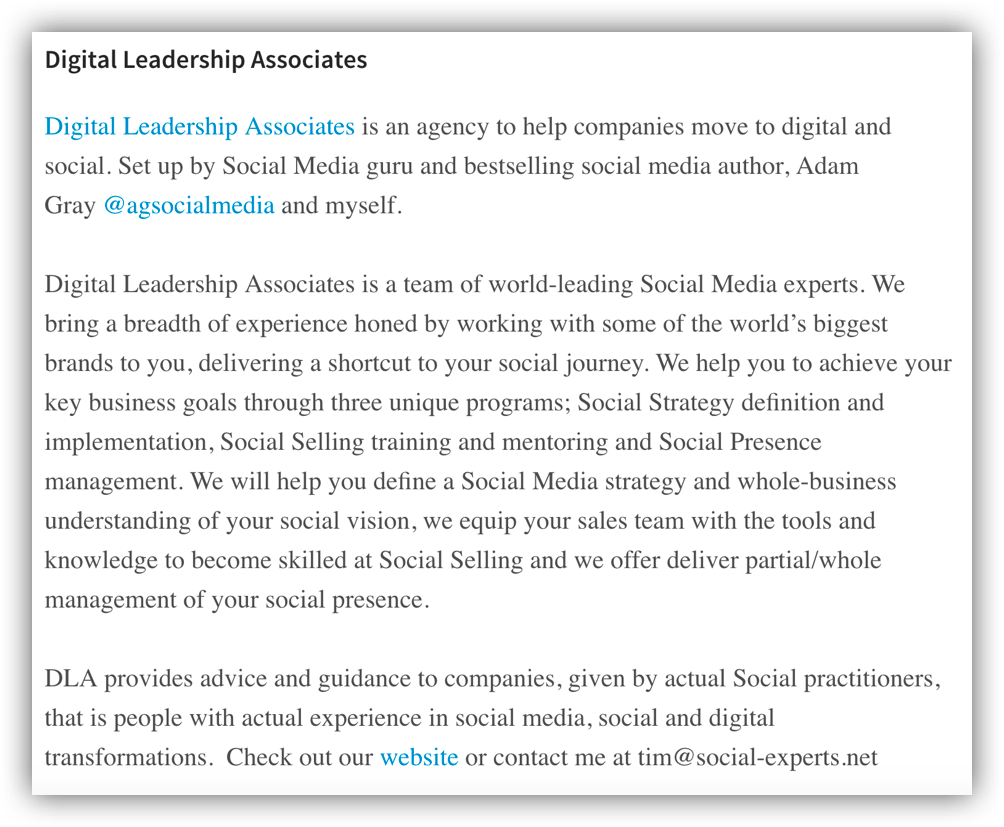
And a bio of the agency he co-founded.
Jeff Bullas takes a similar but shorter approach:
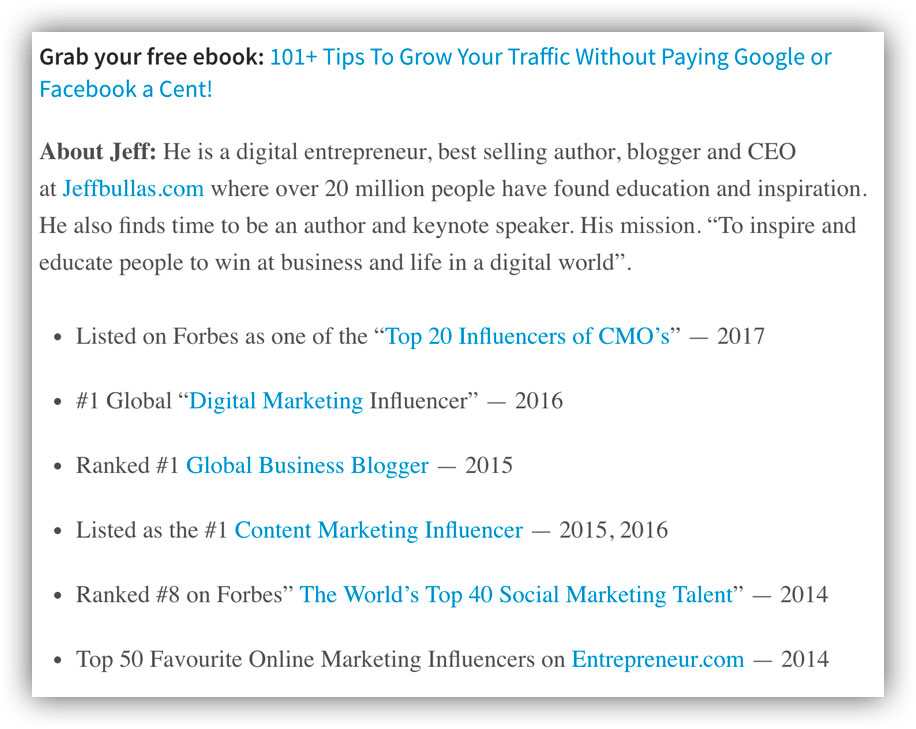
The aim here is not to build interest and make that first purchase – the aim here is to upsell and cross-sell services.
Clearly, this is a more "advanced user" option, as there is a good chance that if your reader doesn’t know who you are, or the value you provide, he’s not going to read through a paragraph or two about you.
And what do you do if you grow beyond Advanced? You do what a digital superstar like Gary Vaynerchuk does.

He doesn’t need a full boilerplate. His bio tells his story effectively, and his posts just end with a cursory link to his website.
2. THE I’M-JUST-TALKING APPROACH
Arguably not a "real" approach, it is still surprisingly effective in the right hands. I like to think of this as an approach towards building credibility. This lends itself mostly to establishing yourself or your company as a thought-leader and an expert in the field, without routing them to an action immediately. You become a trusted resource, a valuable partner in the reader's journey to sales success. This seems to be most effective in situations where you are acting as a consultant. The folks over at Sales Hacker – Max Altschuler and Richard Harris – do this really well. Considering the aim there is to encourage you to sign up for Sales Hacker courses, it's very effective. You feel a close connection with them, and there is almost an aura of mentorship that is created. And because they don't usually push an action, when they do decide to share a CTA, it makes it all the more impactful.
3. THE LET-ME-FIX-THAT-FOR-YOU APPROACH
This is arguably the most common, and maybe the most effective, approach. The simplest way to start your content marketing journey is to take the value proposition that you offer, develop the use-case for it, and then tell the story. In these instances, the entire article acts as a giant CTA – if your readers make it to the second paragraph, it’s the equivalent of staring at a colorful "Click here" button. Your story just needs to get them to click.
This is an approach most favored by companies that are focused on sales enablement and want to help you get more from what you have. That's how we at Paperflite approach it as well. We develop mini-blogs that we use in our outbound communication and lead nurturing, where we describe the value we add in a relatable way. By telling our customers how we can help them triple their sales effectiveness through a use-case that fits them, we were able to boost our responses and engagement significantly.
For a really good example of how to do this well, take a look at Kyle Porter's posts. Kyle uses his posts to encourage you to empathize with his customers, and understand how SalesLoft helps you. He does an extremely good job of this. You’re pulled in to the story, and by the end, you find yourself agreeing with the value he offers. He doesn’t need you to click-through at that point – he knows you’re going to come to find him when your need fits. Classic inbound marketing.
4. THE HERE'S-A-SPECIAL-OFFER APPROACH
Scarcity works. It’s something that every salesperson has always said even before the digital age. Dale Carnegie alluded to it in his seminal book, How to Win Friends and Influence People, all the way back in 1936. Robert Cialdini defined it as one of his six key principles of influence in 1984. Jordan Belfort – The Wolf of Wall Street – claims that just implying scarcity with his tone was one of the key aspects of his communication that helped him close all those sales. Heck, Amazon uses it every day to get us to close our purchases as soon as possible ("order now and get it by 8pm tomorrow!").
It's not surprising then to see that many blog posts use the same approach. It's especially useful if you're trying to push demos and webinars, and get people to make that first micro-purchase, if they will. Gabe Larsen of Inside Sales uses this tactic very effectively to encourage readers to try products and special offers. By coupling his posts with genuinely valuable offers (for instance, a one-hour free training of their Playbook), he provides a powerful reason for you to click through to his landing page.
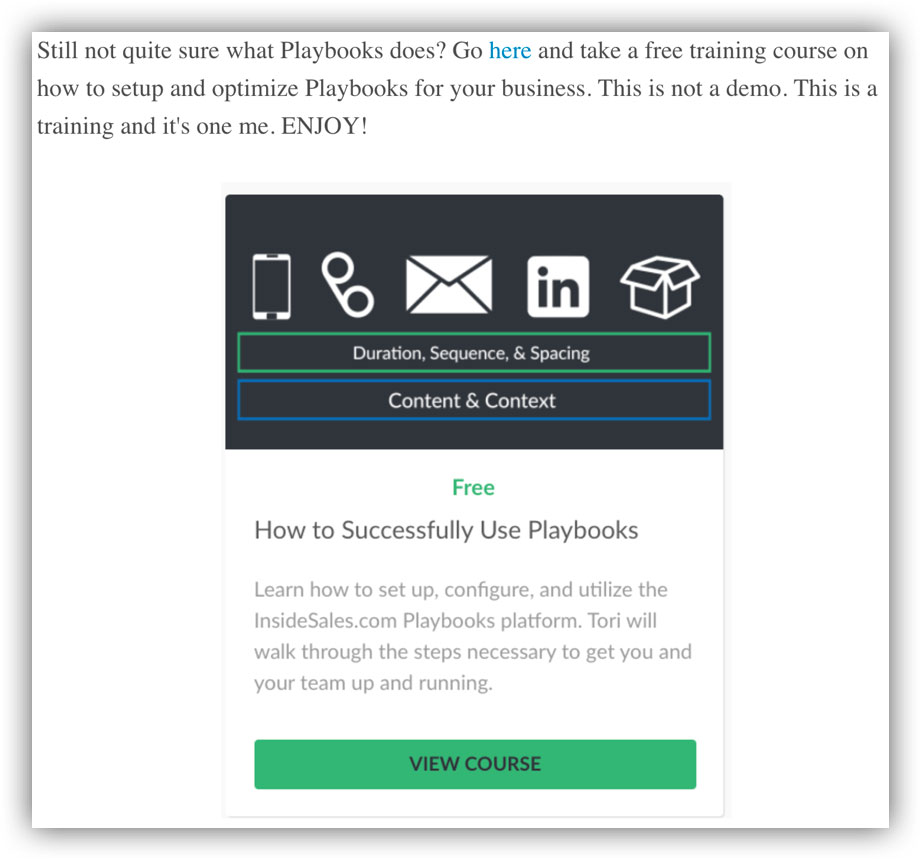
5. THE ENGAGE-WITH-ME APPROACH
Maybe the easiest approach, and as a result, easily abused as well. It’s similar to the I’m-just-talking approach in that it doesn't have any real CTA. However, where it differs is that encourages you to interact with the post itself. You are encouraged to like, share and comment, and engage with the author more. This can be useful for defining yourself as a thought-leader, but where it might be more effective is to make you more visible. By actively pushing for engagement, you are simply asking your reader to notice you, opening the door to more meaningful interactions in the future. What's more, posts with this sort of closing are easier to share and promote than some of the others. Since your only goal is engagement, you can ask prospects or key influencers to comment and share without making them feel that they are promoting you. The same can be said for the non-approach, but as that is a little more passive, it's just ever-so-slightly less effective as an engagement tool, especially if you're just starting out.
6. THE PLAYING-TAG APPROACH
I've saved my favorite for last. This one I really like, mostly because I haven't seen too many of these out in the wild. It's an approach that Chris Orlob for Gong.io likes to use, and I think it's just a really clever way of encouraging you to actually pause and think for a second.
And the beauty of it lies in its simplicity:

Just reading those three words – "tag a friend" – made me stop and think for a second about who might be interested in it. And during that extra second of thought, I actually ran over the article again in my head (reinforcing the message), and compared it to my network (looking for good fits who would be good prospects for Gong.io in turn).
And does it work?
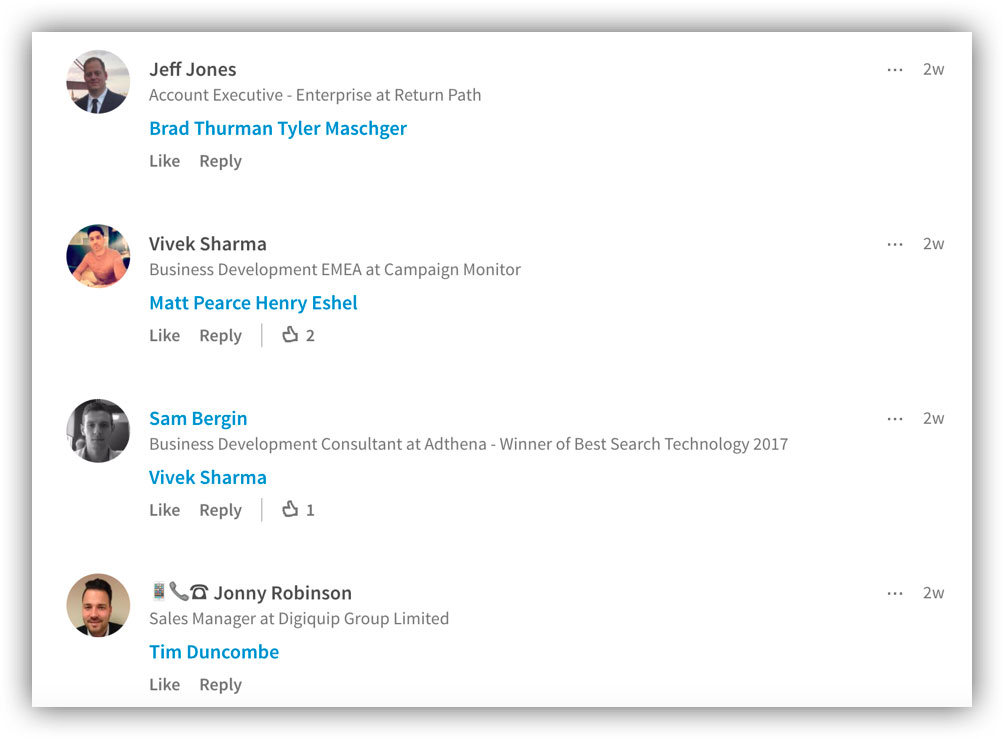
You bet it does.
I’m definitely going to use this tactic in my posts more, and will let you know how it goes!
Side note: For good measure, Chris doesn't just use that as a closing line. Most of his posts end with a graphic, encouraging readers to engage...
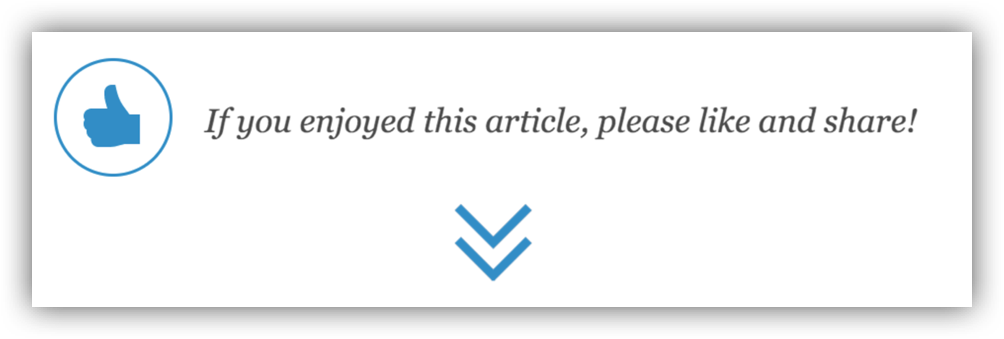
... and every so often, he throws in a few goodies too, just to boost engagement some more, I expect:

Really. Cool.
These 6 buckets, while not all-encompassing, sum up a lot of the more interesting posts that I've read on LinkedIn. Of course, there are always a few very different ones here and there (for instance, there’s the aggregated-list approach, which looks to provide a series of links to outside sources, and establish the authors as a navigator to interesting information), but these were most relevant to me, and hopefully will be for you too, dear sales professional/digital marketer.
If you think I've missed something, please let me know in the comments below.
Or, better yet, "tag a friend that will find this useful in the comments below".
